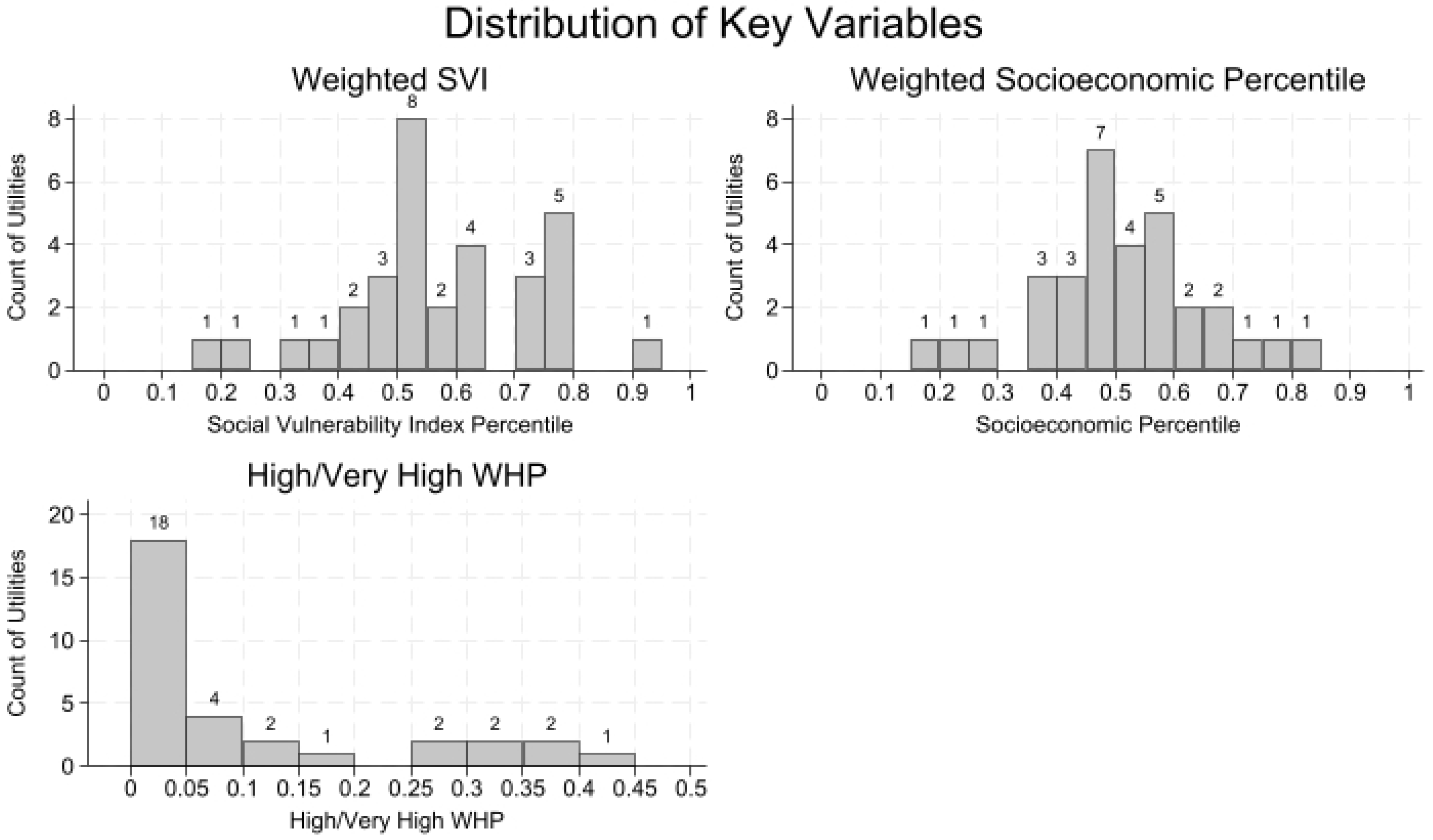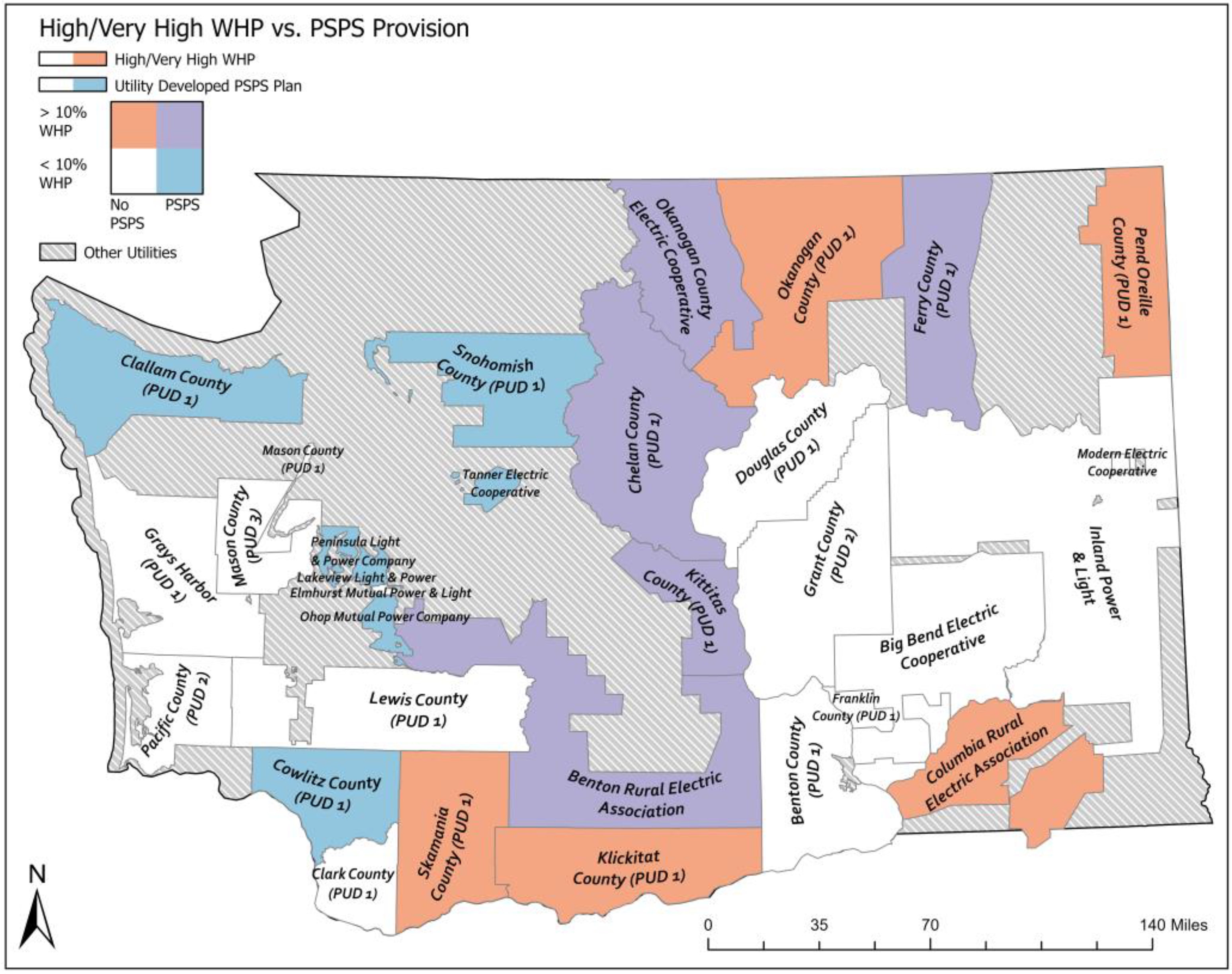Risk Factors and Wildfire Mitigation Planning by Public Utilities in Washington State
Abstract
:1. Introduction
1.1. Background
1.2. Literature Review
2. Materials and Methods
2.1. Data
2.2. Methods
3. Results
3.1. T-Tests
3.2. Logistic Regression
3.2.1. PSPS Provision
3.2.2. Non-Expulsion Fuses
3.2.3. Robustness Checks
3.3. 2 × 2 Matrix
4. Discussion
5. Conclusions
Author Contributions
Funding
Institutional Review Board Statement
Informed Consent Statement
Data Availability Statement
Conflicts of Interest
Abbreviations
| IOU | Investor-owned utility |
| WMP | Wildfire mitigation plan |
| WHP | Wildfire hazard potential |
| SVI | Social vulnerability index |
| PSPS | Public safety power shutoffs |
| WA DNR | Washington Department of Natural Resources |
Appendix A
| Variable | Mean | s.d. | Median | Min | Max |
|---|---|---|---|---|---|
| WHP 84th Percentile | 0.0972 | 0.1394 | 0.0182 | 0 | 0.4224 |
| Social Vulnerability Index | 0.5648 | 0.1698 | 0.5319 | 0.15 | 0.9109 |
| Socioeconomic Percentile | 0.5088 | 0.1454 | 0.5026 | 0.1693 | 0.8227 |
| PSPS Provision | Count | ||||
| 0 | 20 | ||||
| 1 | 12 | ||||
| Total | 32 | ||||
| Non-Expulsion Fuses | Count | ||||
| 0 | 14 | ||||
| 1 | 18 | ||||
| Total | 32 |
References
- Podschwit, H.; Cullen, A. Patterns and Trends in Simultaneous Wildfire Activity in the United States from 1984 to 2015. Int. J. Wildland Fire 2020, 29, 1057–1071. [Google Scholar] [CrossRef]
- Iglesias, V.; Balch, J.K.; Travis, W.R. U.S. Fires Became Larger, More Frequent, and More Widespread in the 2000s. Sci. Adv. 2022, 8, eabc0020. [Google Scholar] [CrossRef] [PubMed]
- Abatzoglou, J.T.; Williams, A.P. Impact of Anthropogenic Climate Change on Wildfire across Western US Forests. Proc. Natl. Acad. Sci. USA 2016, 113, 11770–11775. [Google Scholar] [CrossRef] [PubMed]
- Cullen, A.C.; Axe, T.; Podschwit, H. High-Severity Wildfire Potential—Associating Meteorology, Climate, Resource Demand, and Wildfire Activity with Preparedness Levels. Int. J. Wildland Fire 2020, 30, 30–41. [Google Scholar] [CrossRef]
- Balch, J.K.; Bradley, B.A.; Abatzoglou, J.T.; Nagy, R.C.; Fusco, E.J.; Mahood, A.L. Human-Started Wildfires Expand the Fire Niche Across the United States. Proc. Natl. Acad. Sci. USA 2017, 114, 2946–2951. [Google Scholar] [CrossRef]
- Jazebi, S.; de León, F.; Nelson, A. Review of Wildfire Management Techniques—Part I: Causes, Prevention, Detection, Suppression, and Data Analytics. IEEE Trans. Power Deliv. 2020, 35, 430–439. [Google Scholar] [CrossRef]
- Mitchell, J.W. Power line failures and catastrophic wildfires under extreme weather conditions. Eng. Fail. Anal. 2013, 35, 726–735. [Google Scholar] [CrossRef]
- Kousky, C.; Greig, K.; Lingle, B.; Kunreuther, K. Wildfire Cost in California: The Role of Electric Utilities. Available online: https://esg.wharton.upenn.edu/wp-content/uploads/2018/08/Wildfire-Cost-in-CA-Role-of-Utilities-1.pdf (accessed on 23 February 2025).
- Xie, W.; Meng, Q. Social vulnerability analysis of planned power outages: A spatial study of power outage in California caused by wildfire risk. Sustain. Cities Soc. 2025, 120, 106163. [Google Scholar] [CrossRef]
- Cullen, A.C.; Prichard, S.J.; Abatzoglou, J.T.; Dolk, A.; Kessenich, L.; Bloem, S.; Bukovsky, M.S.; Humphrey, R.; McGinnis, S.; Skinner, H.; et al. Growing Convergence Research: Coproducing Climate Projections to Inform Proactive Decisions for Managing Simultaneous Wildfire Risk. Risk Anal. 2023, 43, 2262–2279. [Google Scholar] [CrossRef]
- California Public Utilities Commission. SED Incident Investigation Report for 2018 Camp Fire with Attachments. 2018. Available online: https://www.cpuc.ca.gov/-/media/cpuc-website/industries-and-topics/documents/wildfire/staff-investigations/i1906015-appendix-a-sed-camp-fire-investigation-report-redacted.pdf?sc_lang=en&hash=FC40497355B496C4BE040275A72A43B4 (accessed on 12 February 2025).
- Solis, N. Former PG&E Executives Agree to $117-Million Settlement over California Wildfires. Los Angeles Times, 29 September 2022. Available online: https://www.latimes.com/california/story/2022-09-29/former-pg-e-executives-announce-117-million-settlement-over-california-wildfires (accessed on 12 February 2025).
- The State of Oregon. Senate Bill 762. 2021. Available online: https://olis.oregonlegislature.gov/liz/2021R1/Downloads/MeasureDocument/SB762/Enrolled (accessed on 1 November 2024).
- Washington Utilities and Transportation Commission. Investor-Owned Utility Wildfire Mitigation Plans. Available online: https://www.wutc.wa.gov/regulated-industries/utilities/energy/electric/wildfires (accessed on 15 February 2025).
- Washington Public Utility Districts Association (WPUDA). FAQs. Available online: https://www.wpuda.org/faqs (accessed on 18 February 2025).
- Washington Rural Electric Cooperative Association. About. Available online: https://www.wreca.coop/about/ (accessed on 18 February 2025).
- Washington State Legislature. Engrossed Second Substitute House Bill 1032: Mitigating the Risk of Wildfires Through Electric Utility Planning and Identification of Best Management Practices. 2023. Available online: https://lawfilesext.leg.wa.gov/biennium/2023-24/Pdf/Bills/Session%20Laws/House/1032-S2.SL.pdf (accessed on 15 February 2025).
- Washington State Department of Natural Resources. Utility Wildfire Mitigation Plans. 2024. Available online: https://www.dnr.wa.gov/about/boards-and-commissions/utility-wildland-fire-prevention-advisory-committee/utility-wildfire (accessed on 12 February 2025).
- Wigtil, G.; Hammer, R.B.; Kline, J.D.; Mockrin, M.H.; Stewart, S.I.; Roper, D.; Radeloff, V.C. Places Where Wildfire Potential and Social Vulnerability Coincide in the Coterminous United States. Int. J. Wildland Fire 2016, 25, 896–908. [Google Scholar] [CrossRef]
- Davies, I.P.; Haugo, R.D.; Robertson, J.C.; Levin, P.S. The Unequal Vulnerability of Communities of Color to Wildfire. PLoS ONE 2018, 13, e0205825. [Google Scholar] [CrossRef]
- Wibbenmeyer, M.; Robertson, M. The Distributional Incidence of Wildfire Hazard in the Western United States. Environ. Res. Lett. 2022, 17, 064031. [Google Scholar] [CrossRef]
- Pollack, M.; Piansky, R.; Gupta, S.; Molzahn, D. Equitably allocating wildfire resilience investments for power grids—The curse of aggregation and vulnerability indices. Appl. Energy 2025, 388, 125511. [Google Scholar] [CrossRef]
- Muhs, J.W.; Parvania, M.; Shahidehpour, M. Wildfire Risk Mitigation: A Paradigm Shift in Power Systems Planning and Operation. IEEE Open Access J. Power Energy 2020, 7, 366–375. [Google Scholar] [CrossRef]
- Arab, A.; Khodaei, A.; Eskandarpour, R.; Thompson, M.P.; Wei, Y. Three lines of defense for wildfire risk management in electric power grids: A review. IEEE Access 2021, 9, 61577–61593. [Google Scholar] [CrossRef]
- Panossian, N.; Elgindy, T. Power System Wildfire Risks and Potential Solutions: A Literature Review & Proposed Metric. 2023. Available online: https://www.nrel.gov/docs/fy23osti/80746.pdf (accessed on 12 February 2025).
- Farnes, A.; Weber, K.; Koerner, C.; Araújo, K.; Forsgren, C. The Power Grid/Wildfire Nexus: Using GIS and Satellite Remote Sensing to Identify Vulnerabilities. Fire 2023, 6, 187. [Google Scholar] [CrossRef]
- Vazquez, D.A.Z.; Qiu, F.; Fan, N.; Sharp, K. Wildfire Mitigation Plans in Power Systems: A Literature Review. IEEE Trans. Power Syst. 2022, 37, 3540–3551. [Google Scholar]
- Mitchell, J.W. Analysis of Utility Wildfire Risk Assessments and Mitigations in California. Fire Saf. J. 2023, 140, 103879. [Google Scholar] [CrossRef]
- Castellon, C.; Saalfeld, H.; Rascon, D. Wildfire Mitigation Considerations for Distribution. In Proceedings of the 2024 IEEE/PES Transmission and Distribution Conference and Exposition (T&D), Anaheim, CA, USA, 6–9 May 2024; IEEE: New York, NY, USA, 2024; pp. 1–5. [Google Scholar] [CrossRef]
- Eccleston, D.T.; Dwyer, J.F.; Harness, R.E.; Barnes, T.A.; Downie, J. Wildfire Risk Reduction Through Wildlife Risk Mitigation. In Proceedings of the 2023 IEEE Rural Electric Power Conference (REPC), Cleveland, OH, USA, 25–28 April 2023; IEEE: New York, NY, USA, 2023; pp. 32–38. [Google Scholar] [CrossRef]
- Huang, C.; Hu, Q.; Sang, L.; Lucas, D.D.; Wong, R.; Wang, B.; Hong, W.; Yao, M.; Donde, V. A Review of Public Safety Power Shutoffs (PSPS) for Wildfire Mitigation: Policies, Practices, Models and Data Sources. IEEE Trans. Energy Mark. Policy Regul. 2023, 1, 187–197. [Google Scholar] [CrossRef]
- Horing, J.; Sue Wing, I.; Lisk, M. Economic Consequences of Wildfire Adaptation: Public Safety Power Shutoffs in California. SSRN 2023. [CrossRef]
- Abatzoglou, J.T.; Smith, C.M.; Swain, D.L.; Ptak, T.; Kolden, C.A. Population Exposure to Pre-Emptive De-Energization Aimed at Averting Wildfires in Northern California. Environ. Res. Lett. 2020, 15, 094046. [Google Scholar] [CrossRef]
- Lesage-Landry, A.; Pellerin, F.; Callaway, D.S.; Taylor, J.A. Optimally Scheduling Public Safety Power Shutoffs. Stoch. Syst. 2023, 13, 438–456. [Google Scholar] [CrossRef]
- Davoudi, M.; Efaw, B.; Avendaño-Mora, M.; Lauletta, J.L.; Huffman, G.B. Reclosing of Distribution Systems for Wildfire Prevention. IEEE Trans. Power Deliv. 2021, 36, 2298–2307. [Google Scholar] [CrossRef]
- Khalili, T.; Davoudi, M.; Bidram, A. Minimizing the Reliability Trade-Off in Wildfires Risk Mitigation. Appl. Energy 2024, 371, 123623. [Google Scholar] [CrossRef]
- U.S. Department of Homeland Security. Homeland Infrastructure Foundation-Level Data. HIFLD Open Data Portal. 2024. Available online: https://hifld-geoplatform.opendata.arcgis.com/ (accessed on 14 February 2025).
- Dillon, G.K. Wildfire Hazard Potential for the United States (270-m), Version 2023, 4th ed.; In Forest Service Research Data Archive; U.S. Department of Agriculture: Fort Collins, CO, USA, 2023. [Google Scholar] [CrossRef]
- Scott, J.H.; Dillon, G.K.; Jaffe, M.R.; Vogler, K.C.; Olszewski, J.H.; Callahan, M.N.; Karau, E.C.; Lazarz, M.T.; Short, K.C.; Riley, K.L.; et al. Wildfire Risk to Communities: Spatial Datasets of Landscape-Wide Wildfire Risk Components for the United States, 2nd ed.; In Forest Service Research Data Archive; U.S. Department of Agriculture: Fort Collins, CO, USA, 2024. [Google Scholar] [CrossRef]
- Flanagan, B.E.; Gregory, E.W.; Hallisey, E.J.; Heitgerd, J.L.; Lewis, B. A Social Vulnerability Index for Disaster Management. Agency for Toxic Substances and Disease Registry; 2011. Available online: https://www.atsdr.cdc.gov/place-health/media/pdfs/2024/07/Flanagan_2011_SVIforDisasterManagement-508.pdf (accessed on 10 February 2025).
- Centers for Disease Control and Prevention. Social Vulnerability Index (SVI) 2022 Documentation: ZCTA Data. 2022. Available online: https://svi.cdc.gov/map25/data/docs/SVI2022Documentation_ZCTA.pdf (accessed on 12 February 2025).
- Cutter, S.L. The origin and diffusion of the social vulnerability index (SoVI). Int. J. Disaster Risk Reduct. 2024, 109, 104576. [Google Scholar] [CrossRef]
- Washington State Department of Commerce. US Dept. of Energy Awards Washington $23.4 Million to Strengthen and Modernize Critical Electric Infrastructure. 2023—Washington State Department of Commerce. Available online: https://www.commerce.wa.gov/us-dept-of-energy-awards-washington-23-4-million-to-strengthen-and-modernize-critical-electric-infrastructure/ (accessed on 11 March 2025).




| PSPS Provision (Mean) | No PSPS Provision (Mean) | Diff | t-Stat | p-Value | |
|---|---|---|---|---|---|
| High/Very High WHP | 0.16 | 0.06 | 0.10 | −2.14 | 0.04 |
| Social Vulnerability Index | 0.51 | 0.59 | −0.08 | 1.37 | 0.18 |
| Socioeconomic Percentile | 0.47 | 0.53 | −0.07 | 1.29 | 0.21 |
| N | 12 | 20 | |||
| Non-Expulsion Fuses (Mean) | No Non-Expulsion Fuses (Mean) | Diff | t-Stat | p-Value | |
| High/Very High WHP | 0.07 | 0.12 | −0.05 | 1.00 | 0.32 |
| Social Vulnerability Index | 0.52 | 0.62 | −0.10 | 1.79 | 0.08 |
| Socioeconomic Percentile | 0.46 | 0.58 | −0.12 | 2.43 | 0.02 |
| N | 18 | 14 |
| Input Variables | PSPS Provision | Non-Expulsion Fuses | ||||||
|---|---|---|---|---|---|---|---|---|
| Model I | Model II | Model III | Model IV | |||||
| β (s.e.) | % | β (s.e.) | % | β (s.e.) | % | β (s.e.) | % | |
| High/Very High WHP | −0.253 (0.169) | −0.260 (0.175) | −0.023 (0.028) | −0.025 (0.029) | ||||
| (High/Very High WHP)2 | 0.009 * (0.005) | 0.009 * (0.005) | ||||||
| Social Vulnerability Index | −0.064 * (0.033) | −6.2 | −0.040 (0.025) | |||||
| Socioeconomic Percentile | −0.069 * (0.037) | −6.67 | −0.070 ** (0.034) | −6.72 | ||||
| Intercept | 2.829 (1.849) | 2.790 (1.911) | 2.758 * (1.500) | 4.085 ** (1.845) | ||||
| Pseudo-R2 | 0.299 | 0.284 | 0.090 | 0.150 | ||||
Disclaimer/Publisher’s Note: The statements, opinions and data contained in all publications are solely those of the individual author(s) and contributor(s) and not of MDPI and/or the editor(s). MDPI and/or the editor(s) disclaim responsibility for any injury to people or property resulting from any ideas, methods, instructions or products referred to in the content. |
© 2025 by the authors. Licensee MDPI, Basel, Switzerland. This article is an open access article distributed under the terms and conditions of the Creative Commons Attribution (CC BY) license (https://creativecommons.org/licenses/by/4.0/).
Share and Cite
Bradbury, N.P.; Cullen, A.C. Risk Factors and Wildfire Mitigation Planning by Public Utilities in Washington State. Fire 2025, 8, 118. https://doi.org/10.3390/fire8030118
Bradbury NP, Cullen AC. Risk Factors and Wildfire Mitigation Planning by Public Utilities in Washington State. Fire. 2025; 8(3):118. https://doi.org/10.3390/fire8030118
Chicago/Turabian StyleBradbury, Nickolas P., and Alison C. Cullen. 2025. "Risk Factors and Wildfire Mitigation Planning by Public Utilities in Washington State" Fire 8, no. 3: 118. https://doi.org/10.3390/fire8030118
APA StyleBradbury, N. P., & Cullen, A. C. (2025). Risk Factors and Wildfire Mitigation Planning by Public Utilities in Washington State. Fire, 8(3), 118. https://doi.org/10.3390/fire8030118








